“Krishna and Radha on a swing” has been added to your cart.
View cart
-
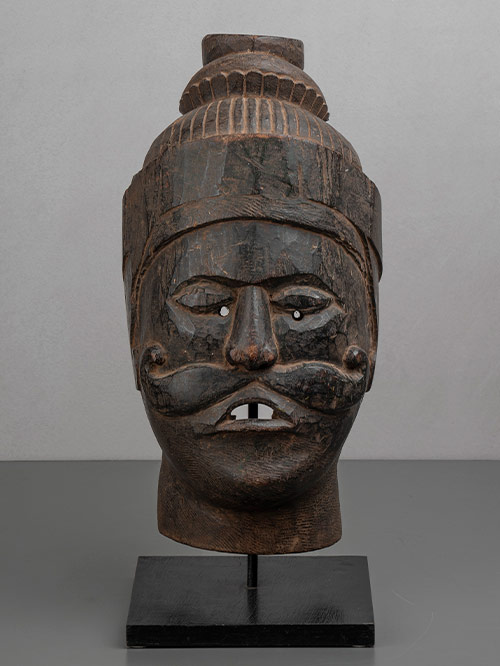
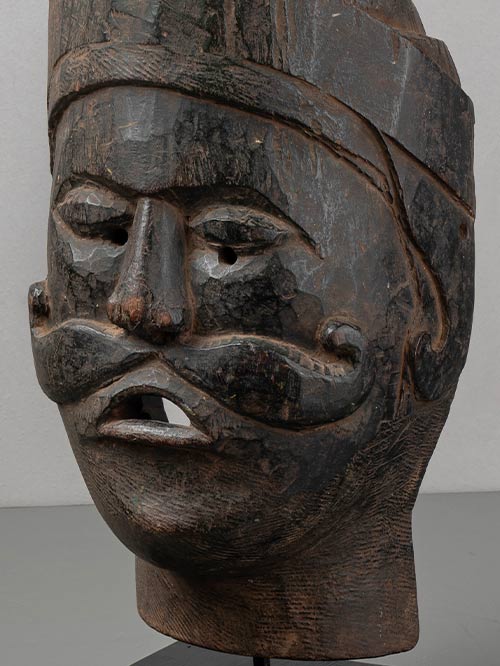
Konkan region (Karnataka)
Wood
An unusual unpainted dancing mask of a male figure worn during performances by members of the Kokna tribe. The stylised face wears a tiered crown and has a prominent upturned moustache sitting over its open mouth. Tiny circular eye holes have been cut out beneath the eyes to help the dancer navigate while wearing the mask.
The Kokna are a major tribe found in Gujarat, Maharashtra, Karnataka, Rajasthan. The tribe carve masks representing mythological characters for the Bhavada festival. This festival is a combination of dance and drama, celebrated during March and April. The masks were carved from soft wood which allows an intricate detailing of various facial expressions. Modern masks are now made from Papier-mâché as they are lighter and more durable.
The characters of the tribal masks represent either deities including Vishnu, Ravana and Ganesha, ancestral spirits, totem, mythological character, animals and birds. Every dancer enacts steps typical of the character whose mask he wears, as he dances to the tune of musical instruments like the Sur, Kahali and Sambal. During the festival procession, masked dancers enact myths from tribal folklore as well as Hindu epics such as the Ramayana and Mahabharata.
Mask Size(cms): 43 (H) x 22 (W) x 15 (D), 48 (H with stand)
Mask Size(inches): 16.9 (H) x 8.7 (W) x 5.9 (D), 18.9 (H with stand)
-
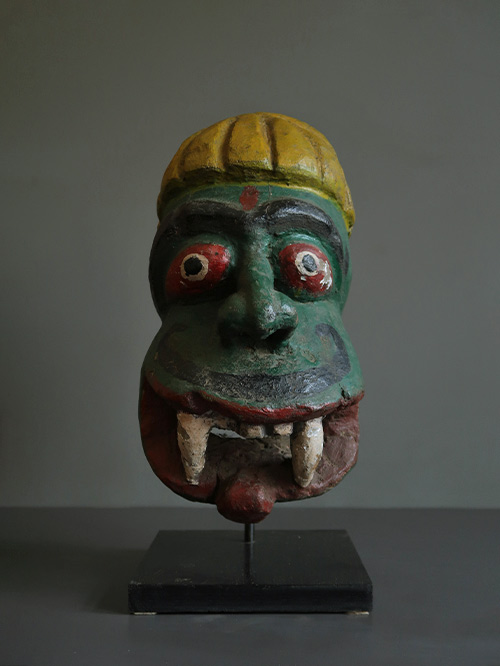
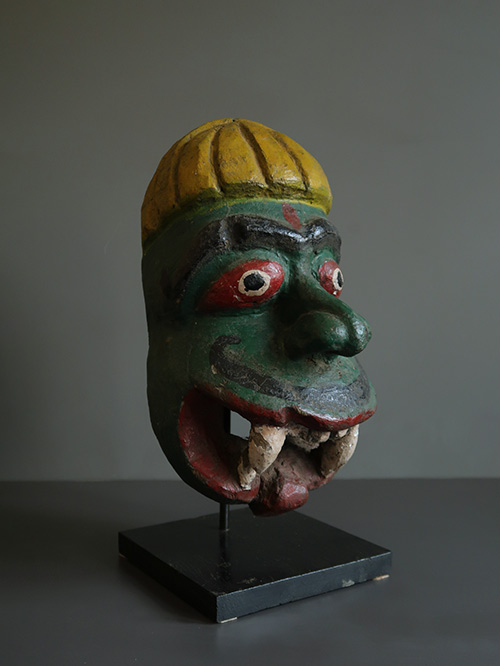
Maharashtra
wood, polychromed
Masks are very popular among the Kukanas and the Warlis of Gujarat and Maharashtra. They are used on ceremonial occasions when dramas are performed to the accompaniment of music and dance. During the festivals of Holi and Diwali mask-shows are organised by itinerant tribal artists in different villages. They serve the purpose of tribal unity and stability and to inculcate respect for tribal traditions and ancestors. When wearing a mask, the tribal artist first decides on the size of the mask—generally larger than the human face— and the fills in details. Painting on the mask is done not as part of the enrichment of the sculpture, but as a means by which the spirit is infused into the mask and thus it comes to life. Traditionally, masks were created out of fear of the natural power around them. People copied the world of animals and birds through symbols, paintings and sketches around them. The fear of the dynamism of nature within and outside, propelled them to create mask as a linkage between his world and the one unknown to him. Masks were treated as instruments of revelations- a pathway to the world of gods and other invisible powers- by giving form to the formless.
Mask Size (cms): 37 (H) x 18 (W) x 22 (D), 45 (H with stand)
Mask Size (inches): 14.6 (H) x 7 (W) x 8.7 (D), 17.7 (H with stand)
-
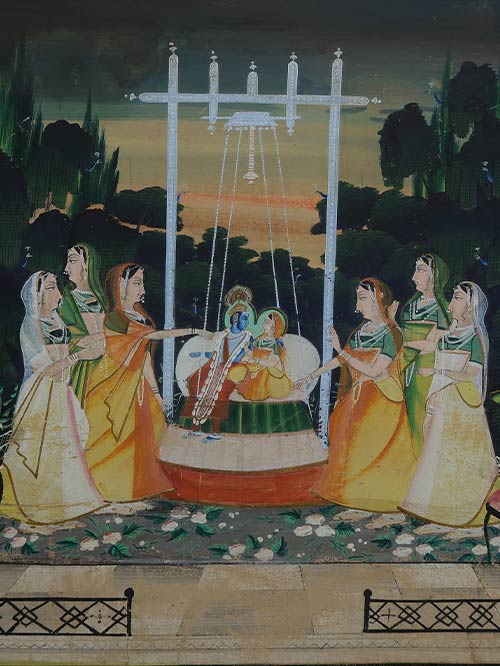
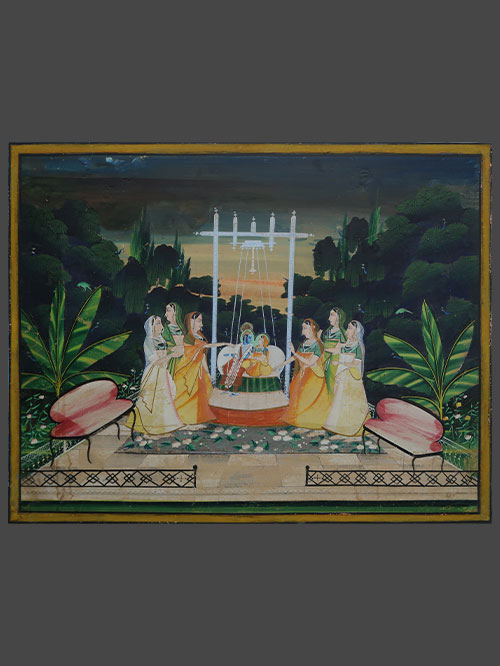
Nathdwara (Rajasthan)
opaque watercolour and gold on paper
Krishna and Radha sit resting against a large white bolster on an ornate silver swing. Underfoot is a floral decorated carpet on a chequered marble floor with iron balustrades. Six female attendants flank the nimbate couple whose gazes are firmly fixed on each other. In the foreground are a pair of European style pink settees while in the distance an orange hued sky indicates the setting sun. Dense clusters of trees and foliage sprinkled with parrots and peacocks envelope the central scene.
Such large and dramatic scenes were painted by Nathdwara artists who produced these images for devotees who visited the great Krishna temple at Nathdwara in Rajasthan. Founded in the 17th century, this temple has attracted an enormous following even to this day, in turn ensuring a continuing tradition of devotional images. The extravagant size and conception of these paintings remind one of the constant importance of religious images in India, not only as ritual objects but also items for pilgrims to acquire and bring home from the great Hindu shrines.
Towards the end of the nineteenth century and early twentieth century Nathdwara artists were exposed for the first time to European art prints whose influence can be seen in the paintings of this period.
Size Painting (cms): 44.5 (H) x 57 (W)
Size Painting (inch): 17.5 (H) x 22.4 (L)
-
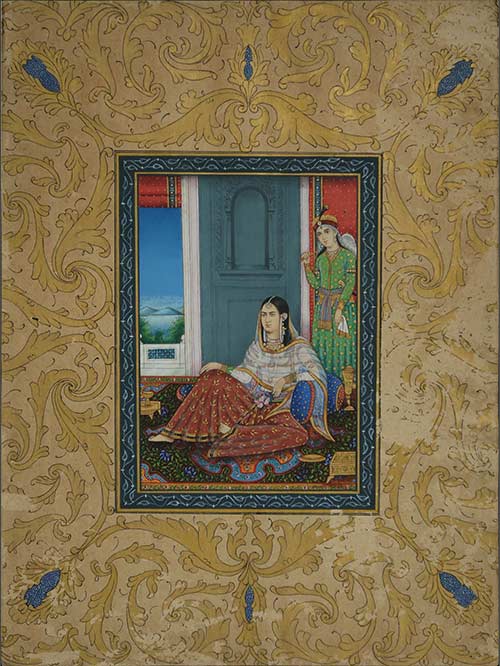
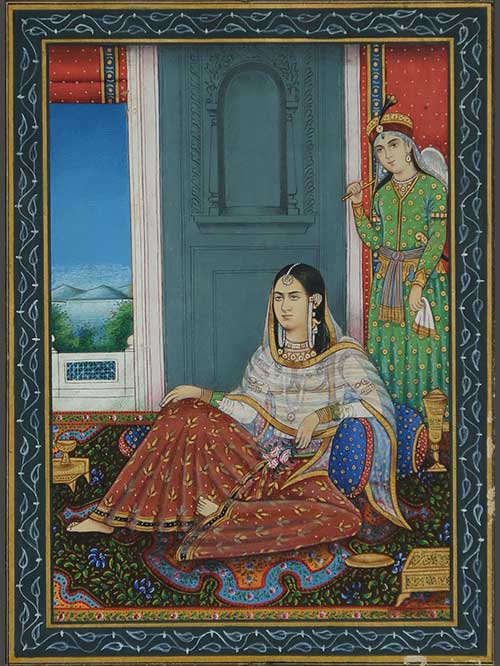
Delhi
pigments and gold on paper, painted gilt arabesque borders
A finely painted portrait of a seated lady, most likely a courtesan, as suggested by her stance and attire. She wears loose fitting pyjamas and a bodice under a diaphanous odhani or veil and is seated against a large blue bolster. A female attendant stands behind her holding a fly-whisk. Assorted gilded cups and a betel box are placed beside her on an intricately patterned floral carpet. A scene of a moonlit lake and hills visible in the distance through a marbled balcony.
Courtesans (tawaifs) occupied an honoured place in the Muslim cultures of India, especially in Lucknow and Delhi. They were trained to be women of great refinement, skilled in music and dancing and appreciative of courtly literature in Persian and Urdu. Their company was eagerly sought by the great men of Delhi, and they would entertain their visitors by performing a nautch (dance).
Miniature Size (cms): 18.3 (L) x 13.5 (W)
Miniature Size (inch): 7.2 (L) x 5.3 (W)
Page Size (cms): 33.5 (L) x 25 (W)
Page Size (inch): 13.2 (L) x 9.8 (W)
-
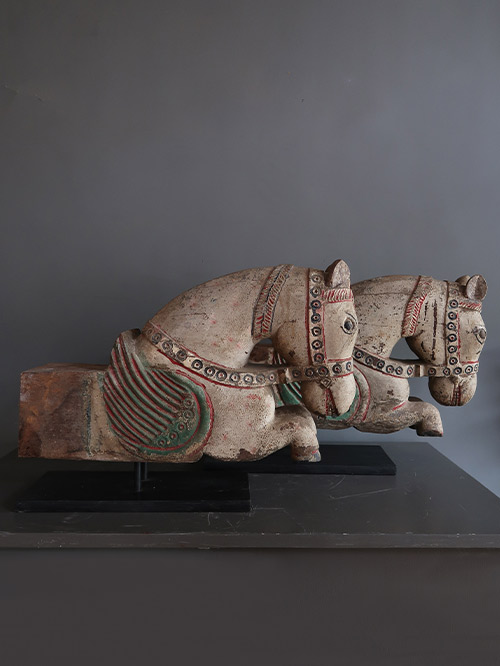

Andhra Pradesh (South India)
Wood
These horse brackets once formed the two ends of a door lintel. The horse or ashva was a very popular motif in architectural wood carvings in South India. Its prototype, the divine Uchchaihshravas emerged from the churning of the ocean. It was white and endowed with wings. The god Indra appropriated it and, after cutting its wings to ensure that it would remain on earth, donated it to mankind.
The horse played a pivotal role in establishing the supremacy of kings, as demonstrated, for instance by the great horse sacrifice, the Ashvamedha, which might have been established in the course of the Vedic period. Equestrian motifs appear prominently in Indian art, for example in Orissan sculpture of the 12th and 13th centuries, and in that of the late Vijaynagara and Nayak periods (early 16th to early 18th century) in southern India. There is a branch of literature specialising in the training of horses, which contains detailed passages on colouring, proportions, gait, auspicious and inauspicious marks and lists of appropriate names for horses.
Individual Sizes (cms): 36 (H) x 61 (W) x 15 (D)
Individual Sizes (inches): 14.2 (H) x 24 (W) x 5.9 (D)
-
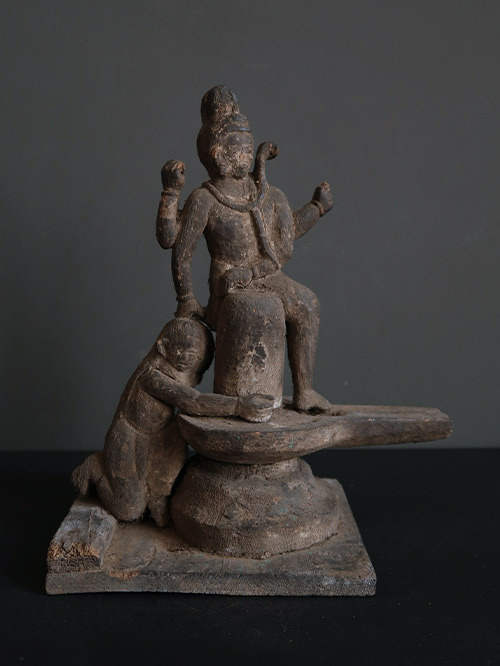

South India
Wood
An unusual group of figures depicting Markandeya embraces a linga. Four-armed Shiva is depicted emerging from the linga, splitting it apart, and with his right foot resting on the yoni. This incident is believed to have happened at Triprangode, Kerala where Lord Shiva appears and kills Yama when the latter appears to take the life of Markandeya who is one of Shiva’s ardent devotees.
Size (cms): 28 (H) x 23 (W) x 16 (D)
Size (inches): 11 (H) x 9 (W) x 6.3 (D)













